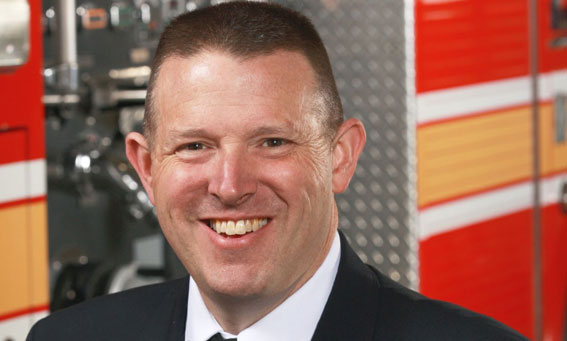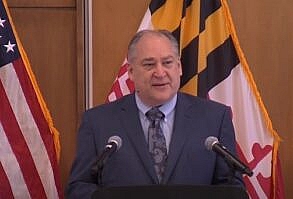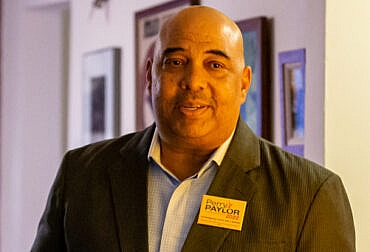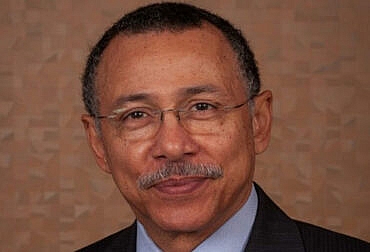Scott E. Goldstein is Fire Chief of The Montgomery County Fire and Rescue Service (MCFRS). Chief Goldstein commands a staff of approximately 2,700 personnel with an infrastructure that includes thirty-seven fire and rescue stations. Chief Goldstein is an active member of the Metropolitan Washington Council of Governments (COG) Fire Chiefs Committee and has served on multiple, related subcommittees in the public safety arena. Chief Goldstein’s educational accomplishments include a Bachelor’s Degree in Fire Science from the University of Maryland as well as a Master’s Degree in Homeland Security from the Naval Post Graduate School. Chief Goldstein’s career in the fire and rescue service is rooted in Montgomery County where as a teenager he first began serving as a volunteer fire fighter rescuer. The interview covers topics of role of volunteers and career staff in MCFRS, Covid, is vaccination required for MCFRS and major task of MCFRS.
Nagender Madavaram: Thanks for joining the meeting. You are in the business of saving lives. You always get appreciations from the residents for your service. What is the best compliment you got so far?
Scott Goldstein: The best compliment is just thanks. Helping people in their time of need is important. First of all, the perception of time is always used in an emergency. It seems like it takes forever for help to get there but at the same time people think, oh my gosh, you got there so fast. The right people in the right place, but as fast as possible to help somebody in their emergency is essential. So, really, we get just thank you
Nagender Madavaram: I observed that Montgomery County Fire Department personnel are efficient and professional. I believe most of the time you get appreciation.
Scott Goldstein: Like I said, we help about 350 times a day. Some of those are low severity events. Some of those are life and death events. Our goal is to get there and help. Make a difference, save a life and get the person the right help that they need. Maybe it puts out their fire. Maybe it saves the cat from a tree. Maybe it picks up the person who got the broken bones and get them to the right hospital facility. We are a customer service organization. Our customers are a million plus residents of the county and all of its visitors. Sometimes in a vulnerable position, sometimes in the most dire and dangerous positions, but we’re there to help. We’re there to stabilize the problem and bring some calm. We do that from experience and we do that from skills that we learn and practice. It’s part of what we do and why the nearly 2,500 folks that are part of the fire department, you know, come to work or come to their station each day to help residents.
The Role of Volunteers and Career Staff in MCFRS:
Nagender Madavaram: Fire Department has permanent employees and good number of volunteers. Can you tell what is the role of volunteers in the department?
Scott Goldstein: So, the fire service started in the mid-1800s as people in the community reacting to a disaster within their community. It started out as a community, like neighbors helping neighbors. That is how volunteer system was started. The system in Montgomery County does dig back through the early 1900s. Some of our organizations have celebrated their Centennial Anniversary and have been around for more than 100 years. Through 100 plus years, things have evolved. I started my career as a volunteer in the mid-1980s, 31 years ago. The organization is combined with career personnel and volunteers. There’s about 2,700 folks, men and women that staffed the apparatus is about 1,200 on the career side and about 1,400 people on the volunteer side. I’ll use the phrase staffing apparatus qualified to answer your 911 call. They all get trained at the same place and the same standard. They all operate under the same policies. They all are managed by the same 911 or the same dispatch center. It is one organization, Montgomery County Fire and Rescue Service. Now there are 19 Volunteer Fire Departments that are a part of Montgomery County Fire and Rescue Service and 37 Fire and Rescue stations. There are stations, usually less than ten of those facilities have volunteers. On the other, roughly 27 Fire and Rescue stations, extraordinarily large percentage of what is provided is through the career staff. People get same quality of service from both the systems. The only way you would know if you look at the patch on the shoulder. More of the slight words on the back of their coat. In reality, career professionals and volunteers provide same service no matter who it is. Currently, about 85% of all of the services are provided by career staff and about 15% by volunteers.
Covid:
Nagender Madavaram: Covid made lives of firemen and paramedical personnel unsafe. In the initial stage of Covid, PPE kits were not available but your personnel attended the calls. What was your experience during early phase of Covid?
Scott Goldstein: It was very scary; nobody knows dangerous situation before we get the time. Indeed, we always deal with infectious and contagious diseases. As one of our job risks, diseases that are transmitted by blood or through droplets or respiratory tract so, it’s a part of our universe. Some variants of COVID are very transmittable and some variants of COVID were less transmittable. There was a lot of coverage of what the hospitals were doing. More protective equipment was needed to be worn to protect people from the risk. At the beginning, there was a lot of unknown and uncertainty risk levels. We could put on more and more protective equipment, but that would become more and more hindering our ability to treat the patient. So, a lot of information was coming in and going out.
Our people were told that what they needed to do to stay safe? What level of protective equipment they needed to wear? We physically transport about 75,000 people a year to the hospitals. We use the protective equipment. We just had to ramp it up for use more of a quicker. It did slow us down a little bit because we would show up outside and we would have to put on this extra equipment before we came inside. So, that was an impact. We had communication and dialogue amongst our personnel, most people understood what we were doing, what was in place and what the steps to take? One of the surges is the face mask, for years, since the mid-80s the fire service used masks and gloves. The EMS service has warned medical gloves on every hole. Prior to COVID, we only wore these on the sickest people and the people that were really coughing and sneezing and making droplets. I’ll use that phrase because that’s what it is. Now, these is a surgical face mask. It’ll be part of our protective equipment for every call. It helps us to keep you healthy. It helps you be protected from us. It helps us be protected from you. I appreciate what our people endured as we learn and adjusted to how to operate in the pandemic environment.
Is Vaccination Required for MCFRS Personnel?
Nagender Madavaram: It is proven that Covid vaccination is necessary to reduce the mortality rate. The controversy is, some of your employees are not in favor of taking vaccination and they are ready to quit the job if the County imposes an order to take the vaccination. It was a challenging task for you to keep your force from quitting the jobs. How did you manage the situation?
Scott Goldstein: Well, it’s again about communication and risk control so we are in risk environment. I wanted to prevent, men and women of the fire service from being exposed to any risk. We wouldn’t go inside burning building and climb into a car and treat somebody before they’re outside of the car. When you control risk, you do it by different measures and layers of measures. So, a vaccination is still a treatment. It is another one of those layers of risk control. What we learn is the protection by different levels of face covers. These are about protecting you from rescue team. It’s about protecting me from you. I’m not going to catch what you have. I maybe a symptomatic person but I’m protecting you by wearing the face cover. So, really, that question changed a lot with Omicron. When Omicron came through the vast majority of people were unvaccinated. People who had been vaccinated could still catch or become sick with the Omicron variant. Indeed, it’s limited to severity of your illness path but it didn’t prevent you from getting the disease. Obviously, that’s what vaccine does. A vaccine provides you some immunity for a level of immunity. It doesn’t provide you a barrier shield.
Nagender Madavaram: Are you saying that without vaccination, you can prevent the transmission of virus from spreading to patient and vice versa by wearing proper PPE?
Scott Goldstein: One of the things that we did pre-Covid with the flu like patient or the patient who was very much coughing and producing droplets as we would put on face cover on them. Every time we got to the patient, placing face cover on the patient if the patient wasn’t already wearing one. It’s another control procedure. Vaccination was a policy discussion that was occurring. We had the public health under control.
Major Task of MCFRS?
Nagender Madavaram: I heard that number of fire incidents are reduced in the county due to regulations of the county such as installation of sprinkler system and fire alarms. Currently, what is your main task?
Scott Goldstein: It’s not Montgomery County Fire Department but it’s Montgomery County Fire and Rescue Services. So, Fire Department that does not do emergency medical services is only addressing a very small portion. EMS portion is the largest portion of what any 911 service adjusts. It’s about 80% our service is for medical circumstance and 20% is the combination of the fire and the public. A car crash, there’s a medical situation. It is the first priority. There may be gasoline leak and there may be oil spill those are hazardous materials situation. The car may be on fire, but the first priority is the injury to the occupant. So, car crash is classified as a medical incident. So, you can see the number of fires has gone down significantly.
This county has had smoke alarm system over 40 years and sprinkler legislation since the mid-90s. Sprinkler requirement and those systems do work absolutely on the occurrences of fire. Still, we respond about three fires a day. So, if you’re going into the kitchen, you put something in the oven, you walk away and you forget it. When the oven catches on fire and it spreads through the kitchen cabinet. The sprinkler system that may be in your residence triggers and puts most of the fire out. That’s still a building fire. That is indeed a building part. So, like I said, we’re dispatched to about three of those a day. We the fire department have to engage in putting out that fire again with our equipment and our hoses.
We are somewhere across these 500 square miles, responding to a fire and it takes a few people to do that safe. So, one of the other strong questions is that sprinkler that thing in your house, is going to put the fire out? The answer is no, it’s not. The sprinkler in a residence is designed to get the resident out and give the residents time to get outside safely. That is an architect protection tool, not a structure protection tool. When you go to a commercial building that has sprinklers, it’s different. The sprinklers in a commercial building are there to put the fire out and to protect the structure. So, the sprinklers that have come about in my 30 years of service, they do a great job of getting time to get out. They may put 90% of the fire out. They may hold the fire. What we say 5 to 7 minutes later the fire department can arrive and takes care of the rest of it but the sprinkler is a tool to help the occupant survive. So, fires are a little bit lower percentage of what we did 40 years ago.
The fires today burn faster and hotter than the fire did 20 years ago. So, I’m going to talk about your chair. The chair you’re sitting on is probably made of foam material. It’s probably made of polymers and lightweight chip wood byproduct. The newer materials are made of lighter and more polys and more polymer. Twenty years ago, it was made of a natural fabric and it was stuffed with real copper or bat cotton. It had metal springs in it. It physically had dimensional wood with material. The couch that you sat in 20 years ago was heavy. It took two to four people just to pick it up and even move it the slightest. The couch that you sit on today may be able to be picked up and moved by one person or very easily too. It’s just a density difference in the component. The new material burns faster and puts more heat than the older material. That makes my job harder because the fires that do occur grow quicker and consume the building faster.











